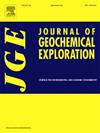Ore forming processes in the multi–stage polymetallic Baycheh-Bagh deposit, NW Iran: Insights from mineralogy, fluid inclusions and stable isotopes
IF 3.3
2区 地球科学
Q1 GEOCHEMISTRY & GEOPHYSICS
引用次数: 0
Abstract
The Baycheh-Bagh polymetallic hydrothermal deposit, in the northwestern part of Urumieh Dokhtar magmatic arc of Iran, is hosted by volcanic and pyroclastic rocks. Multiple mineralization stages are recognized in polyphase veins: the first stage is mainly base-metal mineralization with tetrahedrite group minerals and native gold, the second stage mainly includes native Bi, Ni-Co-Fe arsenides and sulfoarsenides and the third one contains sulfosalts and minor sulfides. The host rocks are affected by hydrothermal alteration to variable degree. Quartz, white micas, adularia, chlorite, calcite and kaolinite are the main alteration minerals.
Fluid inclusion studies reveal that first stage formed mainly due to boiling of hotter high salinity (178.4 to 320.4 °C; avg. 17.5 eq. wt% NaCl) magmatic-hydrothermal fluids but minerals of stages II and III probably precipitated by mixing process of fluids with salinities of 9.7 to 17.5 eq. wt% NaCl eq. and temperatures of 107.4 to 215.1 °C.
Evidence suggesting that a reducing agent from a local source (hydrocarbons, pre-existing sulfides or Fe2+-bearing minerals in host rocks) could have played an important role in change of redox condition and precipitation of arsenides and sulfoarsenides during second stage.
Two sphalerite generations of first stage show FeS content variations (1.09 to 7.97 mol%). The large range of δ34S values (−8.2 to 11.3 ‰) in sulfides from different stages and variation in isotope and chemical composition of different generations of hydrothermal carbonates in the study area indicate ore forming fluids are magmatic as well as partly non-magmatic in origin.
These results suggest that first stage mineralization of Baycheh-Bagh polymetallic veins occurs in intermediate sulfidation epithermal environment, while the second and third stages exhibit features of five-element style mineralization.
伊朗西北Baycheh-Bagh多期多金属矿床的成矿过程:来自矿物学、流体包裹体和稳定同位素的见解
Baycheh-Bagh多金属热液矿床位于伊朗乌鲁木齐多赫塔尔岩浆弧西北部,为火山岩和火山碎屑岩赋存。在多相脉体中可识别出多期成矿作用:第一期以贱金属矿化为主,含四面体群矿物和原生金,第二期以原生Bi、Ni-Co-Fe砷化物和硫代砷化物为主,第三期含硫代盐和少量硫化物。寄主岩不同程度地受到热液蚀变的影响。石英、白云母、紫榴石、绿泥石、方解石和高岭石是主要蚀变矿物。流体包裹体研究表明,第一阶段主要是由于高温高盐度(178.4 ~ 320.4℃)沸腾形成的;(平均17.5 eq. wt% NaCl)岩浆热液,但II期和III期矿物可能是由盐度为9.7 ~ 17.5 eq. wt% NaCl,温度为107.4 ~ 215.1℃的流体混合作用而沉淀的。有证据表明,当地来源的还原剂(碳氢化合物、原生硫化物或寄主岩石中含Fe2+矿物)可能在第二阶段砷化物和硫代砷化物氧化还原条件的改变和沉淀中起重要作用。两代闪锌矿第一阶段的FeS含量差异较大(1.09 ~ 7.97 mol%)。研究区不同阶段硫化物δ34S值(−8.2 ~ 11.3‰)的变化范围较大,不同代碳酸热液的同位素和化学成分的变化表明成矿流体既为岩浆流体,也有部分非岩浆成因。这些结果表明,Baycheh-Bagh多金属脉体的第一期成矿发生在中硫化浅成热液环境中,而第二期和第三期则表现为五元素型成矿特征。
本文章由计算机程序翻译,如有差异,请以英文原文为准。
求助全文
约1分钟内获得全文
求助全文
来源期刊

Journal of Geochemical Exploration
地学-地球化学与地球物理
CiteScore
7.40
自引率
7.70%
发文量
148
审稿时长
8.1 months
期刊介绍:
Journal of Geochemical Exploration is mostly dedicated to publication of original studies in exploration and environmental geochemistry and related topics.
Contributions considered of prevalent interest for the journal include researches based on the application of innovative methods to:
define the genesis and the evolution of mineral deposits including transfer of elements in large-scale mineralized areas.
analyze complex systems at the boundaries between bio-geochemistry, metal transport and mineral accumulation.
evaluate effects of historical mining activities on the surface environment.
trace pollutant sources and define their fate and transport models in the near-surface and surface environments involving solid, fluid and aerial matrices.
assess and quantify natural and technogenic radioactivity in the environment.
determine geochemical anomalies and set baseline reference values using compositional data analysis, multivariate statistics and geo-spatial analysis.
assess the impacts of anthropogenic contamination on ecosystems and human health at local and regional scale to prioritize and classify risks through deterministic and stochastic approaches.
Papers dedicated to the presentation of newly developed methods in analytical geochemistry to be applied in the field or in laboratory are also within the topics of interest for the journal.
 求助内容:
求助内容: 应助结果提醒方式:
应助结果提醒方式:


